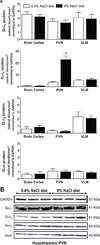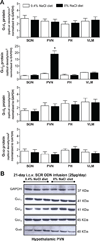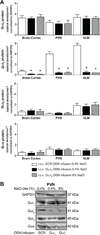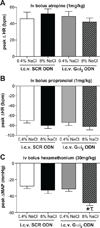Central nervous system Gαi2-subunit proteins maintain salt resistance via a renal nerve-dependent sympathoinhibitory pathway
- PMID: 23213191
- PMCID: PMC3562703
- DOI: 10.1161/HYPERTENSIONAHA.111.00014
Central nervous system Gαi2-subunit proteins maintain salt resistance via a renal nerve-dependent sympathoinhibitory pathway
Abstract
In salt-resistant phenotypes, chronic elevated dietary sodium intake evokes suppression of renal sodium-retaining mechanisms to maintain sodium homeostasis and normotension. We have recently shown that brain Gαi(2) protein pathways are required to suppress renal sympathetic nerve activity and facilitate maximal sodium excretion during acute intravenous volume expansion in Sprague-Dawley rats. Here, we studied the role of brain Gαi(2) proteins in the endogenous central neural mechanisms acting to maintain fluid and electrolyte homeostasis and normotension during a chronic elevation in dietary salt intake. Naive or bilaterally renal denervated adult male Sprague-Dawley rats were randomly assigned to receive an intracerebroventricular scrambled or Gαi(2) oligodeoxynucleotide infusion and then subjected to either a normal salt (0.4%) or high-salt (8.0%) diet for 21 days. In scrambled oligodeoxynucleotide-infused rats, salt loading, which did not alter blood pressure, evoked a site-specific increase in hypothalamic paraventricular nucleus Gαi(2) protein levels and suppression of circulating norepinephrine content and plasma renin activity. In salt-loaded rats continuously infused intracerebroventricularly with a Gαi(2) oligodeoxynucleotide, animals exhibited sodium and water retention, elevated plasma norepinephrine levels, and hypertension, despite suppression of plasma renin activity. Furthermore, in salt-loaded bilaterally renal denervated rats, Gαi(2) oligodeoxynucleotide infusion failed to evoke salt-sensitive hypertension. Therefore, in salt-resistant rats subjected to a chronic high-salt diet, brain Gαi(2) proteins are required to inhibit central sympathetic outflow to the kidneys and maintain sodium balance and normotension. In conclusion, these data demonstrate a central role of endogenous brain, likely paraventricular nucleus-specific, Gαi(2)-subunit protein-gated signal transduction pathways in maintaining a salt-resistant phenotype.
Conflict of interest statement
Figures





References
-
- Franco V, Oparil S. Salt Sensitivity, a determinant of blood pressure, cardiovascular disease and survival. J Med Coll Nutrit. 2006;25:247S–255S. - PubMed
-
- Meneton P, Jeunemaitre X, de Wardener HE, MacGregor GA. Links between dietary salt intake, renal salt handling, blood pressure, and cardiovascular disease. Physiol Rev. 2005;85:679–715. - PubMed
-
- Rodriguez-Iturbe B, Vaziri ND. Salt-sensitive hypertension – update on novel findings. Nephrol Dial Transplant. 2007;22:992–995. - PubMed
-
- Brooks VL, Haywood JR, Johnson AK. Translation of salt retention to central activation of the sympathetic nervous system in hypertension. Clin Exp Pharmacol Physiol. 2005;32:426–432. - PubMed
-
- Lohmeier TE, Hildebrandt W, Hood A. Renal nerves promote sodium excretion during long-term increases in salt-intake. Hypertension. 1999;33:487–492. - PubMed
Publication types
MeSH terms
Substances
Grants and funding
LinkOut - more resources
Full Text Sources
Other Literature Sources
Medical

